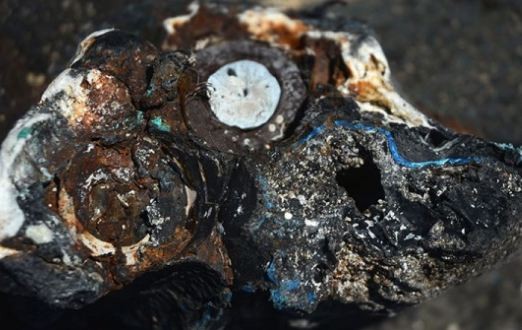Scientists Discover New Kind of "Rock" Made Out of Man-made Garbage
| Arthur Dominic Villasanta | | Jun 19, 2014 09:50 PM EDT |
A plastigomerate rock
Man-made pollution has now given rise to a new form of "mineral" called plastic rock.
Scientists, however, have created an official name for this contemporary anthropogenic phenomenon. They call these plastic rocks made from manmade pollution "plastiglomerates." This word is so new it isn't even in Wikipedia yet.
Like Us on Facebook
Geologist Patricia Corcoran of the University of Western Ontario in London, Canada, and Charles Moore, captain of the oceanographic research vessel Alguita, stumbled upon the plastiglomerates on a beach on the Big Island of Hawaii.
They named the plastic infused garbage rock, plastiglomerates.
These plastiglomerates most likely formed from melting plastic in fires lit by humans, the team said in a story published this month in GSA Today, the magazine of the Geological Society of America.
Corcoran said "... there is the potential for the formation of plastiglomerate" anywhere there is a heat source, such as forest fires or lava flows, and "... abundant plastic debris."
She noted that when plastic melts, it cements rock fragments, sand, and shell debris together. She said some of the plastic is still recognizable as toothbrushes, forks and just "... anything you can think of."
Once the plastic has fused to denser materials like rock and coral, it sinks to the sea floor.
Corcoran and her team scoured Kamilo Beach on the Big Island for more of the plastiglomerates and found them in all 21 sites they searched.
She expects there to be much more plastiglomerates on coastlines across the world. She said plastiglomerates are likely well distributed. It's just never been noticed before now.
The incredible amount of plastic produced since 1950 comes to 6 billion metric tons, enough to encase the entire planet in plastic wrap. Plastic's abundance and its persistence in the environment means there's a good chance it'll get into the fossil record, said paleontologist Jan Zalasiewicz of the University of Leicester in the United Kingdom, who was not involved in the study.
"Plastics, including plastiglomerates, would be one of the key markers by which people could recognize the beginning of the Anthropocene."
Tagsnew, mineral, human, Pollution, plastigomerate, rock, Plastic, discovered
©2015 Chinatopix All rights reserved. Do not reproduce without permission
EDITOR'S PICKS
-

Did the Trump administration just announce plans for a trade war with ‘hostile’ China and Russia?
-

US Senate passes Taiwan travel bill slammed by China
-

As Yan Sihong’s family grieves, here are other Chinese students who went missing abroad. Some have never been found
-

Beijing blasts Western critics who ‘smear China’ with the term sharp power
-

China Envoy Seeks to Defuse Tensions With U.S. as a Trade War Brews
-

Singapore's Deputy PM Provides Bitcoin Vote of Confidence Amid China's Blanket Bans
-

China warns investors over risks in overseas virtual currency trading
-

Chinese government most trustworthy: survey
-

Kashima Antlers On Course For Back-To-Back Titles
MOST POPULAR
LATEST NEWS
Zhou Yongkang: China's Former Security Chief Sentenced to Life in Prison

China's former Chief of the Ministry of Public Security, Zhou Yongkang, has been given a life sentence after he was found guilty of abusing his office, bribery and deliberately ... Full Article
TRENDING STORY

China Pork Prices Expected to Stabilize As The Supplies Recover

Elephone P9000 Smartphone is now on Sale on Amazon India

There's a Big Chance Cliffhangers Won't Still Be Resolved When Grey's Anatomy Season 13 Returns

Supreme Court Ruled on Samsung vs Apple Dispute for Patent Infringement

Microsoft Surface Pro 5 Rumors and Release Date: What is the Latest?










